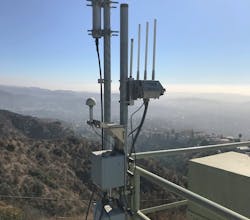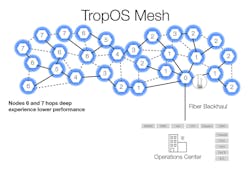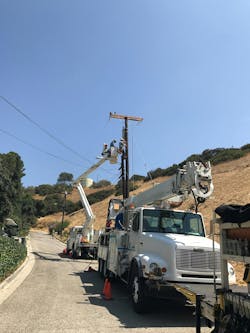How Hybrid Mesh Transformed One California City’s Grid System
California’s Glendale Water and Power Department (GWP) has a nearly century-long history of supplying power and water to its citizens. Serving over 93,000 electric and 34,000 water customers, the utility emphasizes high reliability and embraces new technologies – especially for grid modernization and customer satisfaction.
In recent years, updates to GWP’s grid and communications systems have been a top priority, with increased urban growth driving the need for increased connectivity to more remote locations.
Growing pains
In October 2009, GWP became one of the few public power utilities to receive a U.S. Department of Energy Smart Grid Investment Grant. With this grant, GWP installed smart water and electric meters across the network to modernize its power and water systems. The utility also added water leak detection, electrical sensors, and reclosers to support Distribution Automation (DA). After modernizing the GWP grid using Tropos broadband mesh routers, the network quickly and consistently sent large volumes of data across the GWP grid, delivering end-point performance of up to 15 MB/sec.
Over the past decade, urban population and economic growth, changes in foliage, technological advances, and increased data use combined to create even greater demand for grid reliability, increased capacity, and reduced latency. A larger population meant more remote end-point locations. These remote end-point locations required multiple hops from GWP’s Operations Center, adding congestion to the network. GWP’s operators recognized that the communications system needed to be upgraded as part of grid modernization.
A new hybrid approach
GWP needed a comprehensive, cost-effective solution to account for increased throughput requirements, vegetation growth, and urban development.
GWP sought advice from its vendors. Suggestions ranged from upgrading the metering system and adding more LTE gateways, but the performance of this upgrade was 750 KB/sec to 1 MB/second or selectively adding hybrid LTE routers in areas where communication performance was inadequate. After a detailed analysis, GWP partnered with Hitachi Energy to implement a hybrid solution to resolve operational communication challenges at the optimal cost/benefit.
Hybrid mesh integration
Hitachi Energy leveraged hybrid Tropos/LTE routers to add gateway backhaul locations where fiber was not cost-effective or in areas needing upgraded communication throughput. The solution met the physical challenges of steep terrain, heavy vegetation and new multi-story buildings.
The collaboration between Hitachi Energy and GWP led to the development of a Hybrid LTE design using GWP’s existing broadband mesh and leveraging the LTE capabilities of Hitachi Energy’s TRO620 router to add remote backhaul gateways. The remote gateways could then add increased capacity, performance, and resiliency.
The current mesh deployment includes 382 routers to connect the following:
● 170 Advanced Metering Infrastructure (AMI) devices covering backhaul, meter readings, and disconnection/reconnection.
● 6 devices for capacitor banks
● 32 devices for reclosers
● 45 devices for the PLC used to monitor and control water tank pumps
GWP conducted initial testing for LTE connectivity from remote locations used as backhaul gateways. By adding two TRO620 Hybrid Tropos/LTE routers, encrypted data was passed through an IPsec tunnel over non-private infrastructure, creating a ‘virtual fiber cable’ between the two routers.
GWP placed one TRO620 router at the lower-performing network edge before connecting it to GWP’s broadband mesh network. The second TRO620 unit was installed at a substation, leveraging existing fiber cable to create a virtual connection to the Glendale Wide Area Network (WAN). These changes significantly improved Glendale’s network connectivity performance to over 5 MB/second in the low-performing locations.
Moving forward with “virtual“ fiber
This virtual fiber connection has proven to have multiple operational benefits.
Four additional remote links were added to GWP’s system, and future connections will likely follow a similar hybrid mesh integration model. This enables GWP to establish flexible communications networks, deploying fiber where needed while leveraging broadband mesh to legacy devices to extend network lifespan and reduce CapEx and OpEx.
GWP and Hitachi Energy’s hybrid router collaboration enables continual, cost-effective improvements to GWP’s existing network, supporting the performance required by multiple smart grid applications. Hitachi Energy’s TRO620 router supports legacy technology and prevents stranding previously deployed assets. The ability to seamlessly install and implement a solution within days without compromising network availability is critical for GWP to support future growth.
The future looks bright for Glendale, which will expand the use of the hybrid LTE gateway for capacity injection and performance improvement. By the end of 2024, Glendale plans to phase in the installation of the TRO670 to replace older Tropos routers. The TRO670 is an external mount cellular/ hybrid router designed for harsh outdoor environments. Its design will provide Glendale with short- and long-term cost advantages in the following ways:
● Reduced installation costs because of its ready-to-mount & ready-to-wire design, requiring no holes or external antenna drilling.
● Provide power and swappable battery backup to other radios or end-point devices.
● Optimize the use of pole real estate by allowing consolidation with other wireless devices in a prebuilt enclosure, e.g., 3rd party AMI collector radios.
● Support a phased implementation of new devices that will work in concert with the existing ones, allowing GWP to upgrade performance and leverage the interoperability of the 802.11-based network.
● Minimize OpEx through the selective use of LTE where needed.
● Unify the network management system of private broadband mesh and LTE devices with a single FCAPS (Fault, Configuration, Accounting, Performance, and Security) solution.
Glendale realizes that there is no single solution that supports every application, but by utilizing a solution that incorporates an expandable range of communication technologies, GWP can cost-effectively future-proof their network and improve reliability that will support multiple applications required for all GWP’s grid modernization projects.
About the Author
Dorn Hetzel
Dorn Hetzel is a Senior Technical Consultant at Hitachi Energy. Prior to joining the company in 2012, Dorn had an extensive career in software and systems engineering, including positions with Georgia Tech, Digital Equipment, Control Data, and Ricochet Networks. Dorn has honed his expertise in network and software architecture, as well as software archaeology, with over 40 years of experience in software design and development and more than 25 years in network architecture and engineering, in addition to founding the first commercial ISP in Georgia, Internet Atlanta, in 1992.
Fionan Burke
Fionan T. Burke is a Technical Sales Engineer at Hitachi Energy in North America. He has over 20 years of experience in Networking and Telecommunications, from Triple Play over Fiber and Copper to Wireless Communications for Electrical Utilities and the Oil and Gas industry. In his current role Fionan is leveraging his expertise in Falling Conductor and Protective Relay applications. Fionan received his BA Degree 1991 in Business Administration from Trinity College, University of Dublin, Ireland.
Stephen Kim
Stephen Kim is a Senior IT Application Specialist at Glendale Water & Power. His work involves managing Advanced Metering Infrastructure (AMI) applications and servers which include the backhaul (AMI network, SCADA Network, Hitachi Energy Tropos routers (Hybrid Mesh network), etc.) Stephen joined the company in 2012 and holds Masters of Public Administration from California State University, Northridge and a BA from California State University, Fullerton.
Eric Bayer
Eric Bayer is the Sales Director at Hitachi Energy. Eric joined the company in 2017 after over 20 years in the technology industry working with utility-focused design and engineering tools from Intergraph and Autodesk. Recognized in the GIS, civil, and utility industries as a technologist, Eric excels in supporting projects including drone assessments, outage management, substation design, distribution design and cloud-based applications for fleet and project management. Now, with the proliferation of smart devices Eric has turned his focus to wireless communications infrastructure as an enabling technology for a smarter grid.




